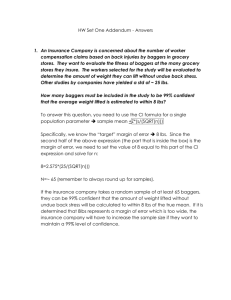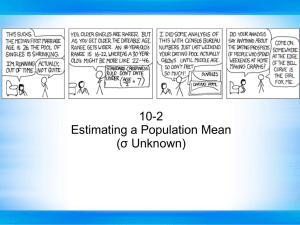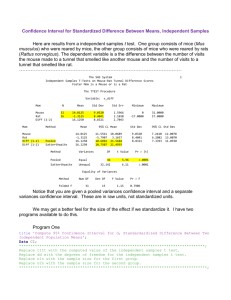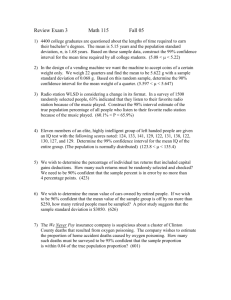Suppose a research firm conducted a survey to
advertisement
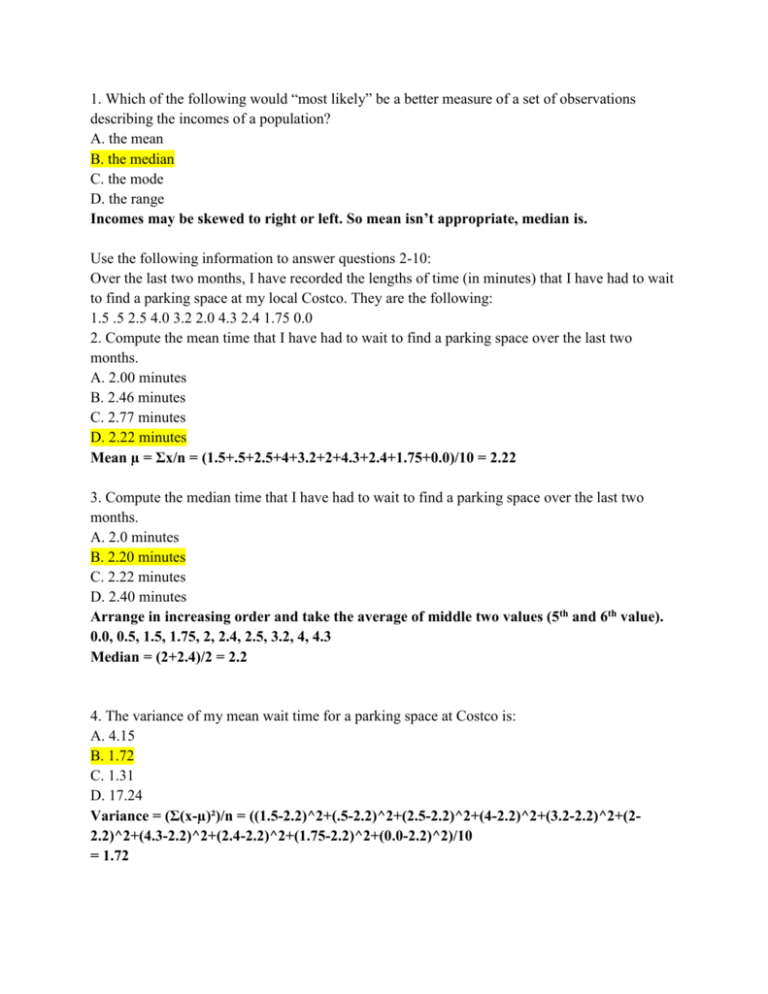
1. Which of the following would “most likely” be a better measure of a set of observations describing the incomes of a population? A. the mean B. the median C. the mode D. the range Incomes may be skewed to right or left. So mean isn’t appropriate, median is. Use the following information to answer questions 2-10: Over the last two months, I have recorded the lengths of time (in minutes) that I have had to wait to find a parking space at my local Costco. They are the following: 1.5 .5 2.5 4.0 3.2 2.0 4.3 2.4 1.75 0.0 2. Compute the mean time that I have had to wait to find a parking space over the last two months. A. 2.00 minutes B. 2.46 minutes C. 2.77 minutes D. 2.22 minutes Mean µ = Σx/n = (1.5+.5+2.5+4+3.2+2+4.3+2.4+1.75+0.0)/10 = 2.22 3. Compute the median time that I have had to wait to find a parking space over the last two months. A. 2.0 minutes B. 2.20 minutes C. 2.22 minutes D. 2.40 minutes Arrange in increasing order and take the average of middle two values (5th and 6th value). 0.0, 0.5, 1.5, 1.75, 2, 2.4, 2.5, 3.2, 4, 4.3 Median = (2+2.4)/2 = 2.2 4. The variance of my mean wait time for a parking space at Costco is: A. 4.15 B. 1.72 C. 1.31 D. 17.24 Variance = (Σ(x-µ)²)/n = ((1.5-2.2)^2+(.5-2.2)^2+(2.5-2.2)^2+(4-2.2)^2+(3.2-2.2)^2+(22.2)^2+(4.3-2.2)^2+(2.4-2.2)^2+(1.75-2.2)^2+(0.0-2.2)^2)/10 = 1.72 5. By the way, how many times have I visited Costco in the last two months? A. 10 B. 9 C. unknown, because this is a sample of the number of times that I have really visited D. 8, due to (n-1) degrees of freedom Count n = 10 6. Using the data above, what is the probability that the next time I visit Costco, I will be able to find a parking space in 1.5 minutes? A. 15 percent B. 1.5 percent C. 10 percent D. 90 percent Probability = Number of times 1.5 occur / Total number of times = 1/10 = 10% 7. The data above can best be described by a: A. discrete probability distribution B. continuous probability distribution C. neither Time is contiuous. 8. The distribution of my wait time for a parking space at Costco follows a normal distribution. What is the probability that next time I visit Costco, my wait time for a parking space will be less than 5 minutes? A. 100% B. 98% C. 48% D. 2.12% P(x<5)=P(z < (x-µ)/σ) = P(z < (5-2.22)/sqrt(1.72)) = P(z<2.12) = 98% 9. The distribution of my wait time for a parking space at Costco follows a normal distribution. What is the probability that next time I visit Costco, my wait time for a parking space will be between 2.22 and 4 minutes? A. .4131 B. .0900 C. .9100 D. .0136 Z for 2.22 = (2.22-2.22)/sqrt(1.72) = 0 Z for 4 = (4-2.22)/sqrt(1.72) = 1.357 P(0<z<1.357) = P(z<1.357)-P(z<0) = 0.913 - 0.5 = 0.413 10. The distribution of my wait time for a parking space at Costco follows a normal distribution. What is the probability that next time I visit Costco, my wait time for a parking space will be between .5 and 4 minutes? A. 41 percent B. 40 percent C. 99 percent D. 81 percent Z for 0.5 = (0.5-2.22)/sqrt(1.72) = -1.312 Z for 4 = (4-2.22)/sqrt(1.72) = 1.357 P(-1.312<z<1.357) = P(z<1.357) - P(z<-1.312) = 0.913 - 0.095 = 0.81 = 81% Open the following link: www.ual.com and enter fictitious information for a round trip flight of your choice. When you are given several itinerary choices, review the operation trends under “flight details” for your departure or return and answer questions #11-12. 11. These operational trends were most likely calculated using a: A. Poisson distribution B. Standard normal distribution C. Binomial probability distribution D. Relative frequency distribution It would have been obtained from actual data without assuming any distribution. 12. Which of the following would you most likely use to calculate the probability that exactly 2 of the many departures offered on your chosen date would arrive late, given the probability that any of the departing flights arriving late is .08? A. Poisson distribution B. Standard normal distribution C. Binomial probability distribution D. Relative frequency distribution Binomial probability as there are only two possibilities, late or not late, also probability of each flight being late is same. 13. The wildlife department has been feeding a special food to rainbow trout fingerlings in a pond. A sample of the weights of 40 trout revealed that the mean weight is 402.7 grams and the standard deviation 8.8 grams. What is the probability that the mean weight for a sample of 40 trout exceeds 405.5 grams? A. 0.3783 B. 0.0228 C. 1.0 D. 0.5 Distribution of ‘Means’ has standard error = 8.8/sqrt(40) = 1.3914 Mean value of distribution remains same = 402.7 So, P(x>405.5) = P(z > (405.5-402.7)/1.3914) = P(z>2.012) = 0.022 14. For a distribution of sample means constructed by sampling 5 items from a population of 15, A. the sample size is 15 B. there will be 3003 possible sample means C. the mean of the sample means will be 3 D. the standard error will be 1 Possible number of samples chosen = 15C5 = 3003 15. An accounting firm is planning for the next tax preparation season. From last year's returns, the firm collects a systematic random sample of 100 filings. The 100 filings showed an average preparation time of 90 minutes with a standard deviation of 140 minutes. What assumptions do you need to make about the shape of the population distribution of all possible tax preparation times to make inferences about the average time to complete a tax form? A. The population distribution is skewed to the right. B. The population distribution is skewed to the left. C. The population distribution is normal. D. The shape of the population distribution does not matter. Must assume normality before using normal distribution formulas for inferring means. 16. The mean weight of trucks traveling on a particular section of I-475 is not known. A state highway inspector needs an estimate of the mean. He selects a random sample of 49 trucks passing the weighing station and finds the mean is 15.8 tons, with a standard deviation of the sample of 4.2 tons. What is probability that a truck will weigh less than 14.3 tons? A. 0.0062 B. 0.3632 C. 0.1368 D. 0.4938 P(x<14.3) = P(z<(14.3-15.8)/4.2) = P(z<-0.357) = 0.36 17. An experiment involves selecting a random sample of 256 middle managers at random for study. One item of interest is their mean annual income. The sample mean is computed to be $35,420 and the sample standard deviation is $2,050. What is the standard error of the mean? A. $128.125 B. $138.36 C. $2,050 D. $8.01 Standard error = 2050/sqrt(256) = 128.125 18. An accounting firm is planning for the next tax preparation season. From last year's returns, the firm collects a systematic random sample of 100 filings. The 100 filings showed an average preparation time of 90 minutes with a standard deviation of 140 minutes. What is the probability that the mean completion time is between 1 and 2 hours, i.e., 60 and 120 minutes? A. Approximately 1 B. 0.1664 C. 0.8336 D. 0.9676 For distribution of ‘Means’, mean remains same but Standard error of mean = 140/sqrt(100) = 14 Z for 60 = (60-90)/14 = -2.143 Z for 120 = (120-90)/14 = 2.143 P(-2.143<z<2.143) = 0.96 19. A group of statistics students decided to conduct a survey at their university to find the average (mean) amount of time students spend studying per week. Based on a simple random sample, they surveyed 144 students. The statistics showed that students studied an average of 20 hours per week with a standard deviation of 10 hours. What is the probability that average student study time is between 18 and 22 hours? A. 0.9640 B. 0.0160 C. 0.0360 D. 0.9840 Standard error = 10/sqrt(144) = 0.833 Z for 18 = (18-20)/0.833 = -2.401 Z for 22 = (22-20)/0.833 = 2.401 P(-2.401<z<2.401) = 0.984 20. An accounting firm is planning for the next tax preparation season. From last year's returns, the firm collects a systematic random sample of 100 filings. The 100 filings showed an average preparation time of 90 minutes with a standard deviation of 140 minutes. What is the probability that the mean completion time will be more than 120 minutes? A. Approximately zero B. 0.0832 C. 0.4168 D. 0.0162 Standard error = 140/sqrt(100) = 14 Z for 120 = (120-90)/14 = 2.143 P(z>2.143) = 0.016 21. Suppose a research firm conducted a survey to determine the average amount of money steady smokers spend on cigarettes during a week. A sample of 100 steady smokers revealed that the sample mean is $20 and the sample standard deviation is $5. What is the probability that a sample of 100 steady smokers spend between $19 and $21? A. 0.4772 B. 0.0228 C. 0.9544 D. $20 Standard error = 5/sqrt(100) = 0.5 Z for 19 = (19-20)/0.5 = -2 Z for 21 = (21-20)/0.5 = 2 P(-2<z<2) = 0.954 22. For a sampling distribution of the means, which of the following would be between ? 1.96 standard deviations? A. 95% of the sampling means B. 95% of the population means C. 95% of the variance or dispersion D. 95% of the sampling error Because distribution is of sample means. 23. A 95 percent confidence interval implies that about 95 out of 100 similarly constructed intervals will include the _____________ being estimated. A. sample parameter B. sample interval C. population parameter D. population interval By definition 24. What happens to the computed value of t as the sample size increases? A. it stays constant B. it increases C. it falls, then rises D. it decreases As sample size increases, standard error (SE) decreases, so t increases. SE = s/sqrt(n) t = (x-µ)/SE 25. In terms of the standard error of the mean, how wide is a 90 percent confidence interval? A. 2.58 B. 1.96 C. 3.30 D. 1.65 Width on either side = z*SE For 90% confidence, critical value of z = ±1.65. So, total 2*1.65 = 3.30 wide. 26. How is the t distribution similar to the standard z distribution? A. Both are continuous distribution B. Both are bell-shaped C. Both are families of distributions D. A and B By definition 27. When using Student's t to compute an interval estimate, A. we assume that the samples are collected from normally distributed populations B. we estimate the population standard deviation based on the sample standard deviation C. we use the z distribution D. A and B only By definition 28. A 95% confidence interval infers that the population mean A. is between 0 and 100% B. is within ?1.96 standard deviations of the sample mean C. is within ?1.96 standard errors of the sample mean D. is too large Since distribution is for sample means and 95% confidence give critical value ±1.96. 29. A student wanted to construct a 95% confidence interval for the average age of students in her statistics class. She randomly selected 9 students. Their average age was 19.1 years with a standard deviation of 1.5 years. What is the 95% confidence interval for the population mean? A. [0.97, 3.27] B. [15.64, 22.56] C. [17.97, 20.23] D. [17.95, 20.25] Degree of freedom = 9-1 = 8 Critical t for 95% confidence = ±2.306 Margin of error = 2.306*1.5/sqrt(9) = 1.15 Lower limit = 19.1 - 1.15 = 17.95 Upper limit = 19.1 + 1.15 = 20.25 30. A survey of 50 retail stores revealed that the average price of a microwave was $375 with a standard error of $20. Assuming the population is normally distributed, what is the 99% confidence interval to estimate the true cost of the microwave? A. $367.42 to $382.58 B. $315.00 to $415.00 C. $323.40 to $426.60 D. $335.82 to $414.28 Degree of freedom = 50-1 = 49 Critical t = 2.68 Given Standard error SE = 20 Margin of error = t*SE = 2.68*20 = 53.6 Lower limit = 375-53.6 = 321.4 Upper limit = 375+53.6 = 428.6 31. Which of the following is NOT necessary to determine how large a sample to select from a population? A. Level of confidence in estimating the population parameter B. Size of the population C. Maximum allowable error in estimating the population parameter D. Estimate of the population variation Confidence interval is Xbar ± zs/sqrt(n) Z from level of confidence, zs/sqrt(n) is maximum allowable error, s/sqrt(n) is estime of population variation. Size of population isn’t included. 32. A group of statistics students decided to conduct a survey at their university to find the average (mean) amount of time students spent studying per week. They sampled 240 students and found a mean of 22.3 hours per week. Assuming a population standard deviation of 6 hours, what is the 99% level of confidence? A. [21.80, 22.80] B. [16.3, 28.3] C. [21.30, 23.30] D. [20.22, 22.0] 99% confidence gives critical value of z as 2.576 Lower limit = 22.3-2.576*6/sqrt(240) = 21.3 Upper limit = 22.3+2.576*6/sqrt(240) = 23.3 33. When a confidence interval for a population mean is constructed from sample data, A. we can conclude that the population mean is in the interval B. we can conclude that the population mean is not in the interval C. we can conclude, for an infinite number of samples and corresponding confidence intervals, that the population mean is in a stated percentage of the intervals D. we cannot make any inferences By definition 34. A survey of an urban university (population of 25,450) showed that 750 of 1100 students sampled attended a home football game during the season. Using the 90% level of confidence, what is the confidence interval for the proportion of students attending a football game? A. [0.7510, 0.8290] B. [0.6620, 0.6980] C. [0.6659, 0.6941] D. [0.6795, 0.6805] Observed proportion = 750/1100 = 0.68182 For 90% confidence critical z = 1.64485 Standard error = sqrt(0.68182*(1-0.68182)/1100) = 0.01404 Lower limit = 0.68182 - 1.64485*0.01404 = 0.6587 Upper limit = 0.68182 + 1.64485*0.01404 = 0.7049 35. Recently, a university surveyed recent graduates of the English Department for their starting salaries. Four hundred graduates returned the survey. The average salary was $25,000 with a standard deviation of $2,500. A 95% confidence interval is constructed. What does the confidence interval mean? A. The population mean is in the interval B. The population mean is not in the interval C. The likelihood that any confidence interval based on a sample of 400 graduates will contain the population mean is 0.95 D. There is a 5% chance that the computed interval does not contain the population mean By definition. Use the following information to answer questions #36-38. Nike’s annual report says that the average American buys 6.5 pairs of sports shoes per year. Suppose the population standard deviation is 2.1 and that a sample of 81 customers will be examined next year. 36. What is the standard error of the mean in this experiment? A. .0259 B. .0233 C. .2333 D. .4666 SE = 2.1/sqrt(81) = 0.233 37. What is the probability that the sample mean is between 6 and 7 pairs of sports shoes? A. 90% B. 95% C. 97% D. 99% Z for 6 = (6-6.5)/0.233 = -2.146 Z for 7 = (7-6.5)/0.233 = 2.146 P(-2.146<z<2.146) = 0.97 = 97% 38. What is the probability that the difference between the sample mean and the population mean is less than .25 pairs? A. 72% B. 35% C. 70% D. 17.5% Difference of less than 0.25 means sample mean is between 6.25 and 6.75. Z for 6.25 = (6.25-6.5)/0.233 = -1.073 Z for 6.75 = (6.75-6.5)/0.233 = 1.073 P(-1.073 < z < 1.073) = 0.72 = 72% 39. Assuming the same sample size and the same standard deviation, a 90 percent confidence interval will be ______ a 95 percent confidence interval. A. equal to B. wider than C. narrower than D. cannot be determined As confidence level decreases, critical value of z or t decreases, thus margin of error and the interval width decreases. 40. Which of the following allows us to know nothing about the shape of the population distribution, but yet make conclusions regarding the distribution of the sample mean? A. the Empirical Probability Assumption B. the Z-score C. the t-statistic D. the Central Central Limit theorem says sample means are almost normally distributed irrespective of the shape of population distribution.




